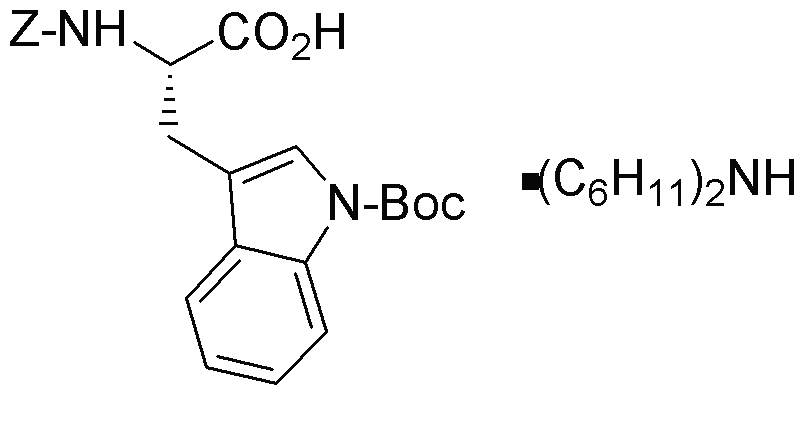Na-Z-Nin-Boc-L-tryptophan dicylohexylammonium salt is widely utilized in research focused on:
- Pharmaceutical Development: This compound serves as a key intermediate in the synthesis of various pharmaceuticals, particularly those targeting neurological disorders, due to its tryptophan structure that can influence serotonin pathways.
- Peptide Synthesis: It is commonly used in the solid-phase peptide synthesis process, facilitating the creation of complex peptides that are crucial for drug discovery and development.
- Biochemical Research: Researchers leverage this compound to study protein interactions and enzyme activities, enhancing our understanding of biological processes and disease mechanisms.
- Cosmetic Formulations: The compound is incorporated into cosmetic products for its potential benefits in skin health, owing to its amino acid properties that may aid in hydration and skin repair.
- Food Industry Applications: It can be explored as a flavoring agent or nutritional supplement, providing a source of essential amino acids that support overall health and well-being.
General Information
Properties
Safety and Regulations
Applications
Na-Z-Nin-Boc-L-tryptophan dicylohexylammonium salt is widely utilized in research focused on:
- Pharmaceutical Development: This compound serves as a key intermediate in the synthesis of various pharmaceuticals, particularly those targeting neurological disorders, due to its tryptophan structure that can influence serotonin pathways.
- Peptide Synthesis: It is commonly used in the solid-phase peptide synthesis process, facilitating the creation of complex peptides that are crucial for drug discovery and development.
- Biochemical Research: Researchers leverage this compound to study protein interactions and enzyme activities, enhancing our understanding of biological processes and disease mechanisms.
- Cosmetic Formulations: The compound is incorporated into cosmetic products for its potential benefits in skin health, owing to its amino acid properties that may aid in hydration and skin repair.
- Food Industry Applications: It can be explored as a flavoring agent or nutritional supplement, providing a source of essential amino acids that support overall health and well-being.
Documents
Safety Data Sheets (SDS)
The SDS provides comprehensive safety information on handling, storage, and disposal of the product.
Product Specification (PS)
The PS provides a comprehensive breakdown of the product’s properties, including chemical composition, physical state, purity, and storage requirements. It also details acceptable quality ranges and the product's intended applications.
Certificates of Analysis (COA)
Search for Certificates of Analysis (COA) by entering the products Lot Number. Lot and Batch Numbers can be found on a product’s label following the words ‘Lot’ or ‘Batch’.
Numéro de catalogue
Numéro de lot/série
Certificates Of Origin (COO)
This COO confirms the country where the product was manufactured, and also details the materials and components used in it and whether it is derived from natural, synthetic, or other specific sources. This certificate may be required for customs, trade, and regulatory compliance.
Numéro de catalogue
Numéro de lot/série
Safety Data Sheets (SDS)
The SDS provides comprehensive safety information on handling, storage, and disposal of the product.
DownloadProduct Specification (PS)
The PS provides a comprehensive breakdown of the product’s properties, including chemical composition, physical state, purity, and storage requirements. It also details acceptable quality ranges and the product's intended applications.
DownloadCertificates of Analysis (COA)
Search for Certificates of Analysis (COA) by entering the products Lot Number. Lot and Batch Numbers can be found on a product’s label following the words ‘Lot’ or ‘Batch’.
Numéro de catalogue
Numéro de lot/série
Certificates Of Origin (COO)
This COO confirms the country where the product was manufactured, and also details the materials and components used in it and whether it is derived from natural, synthetic, or other specific sources. This certificate may be required for customs, trade, and regulatory compliance.


